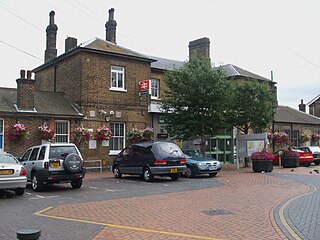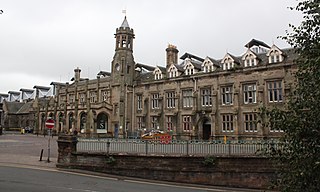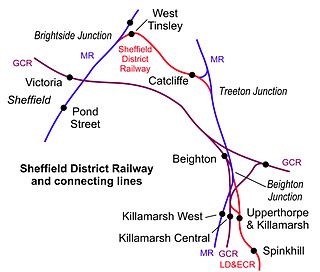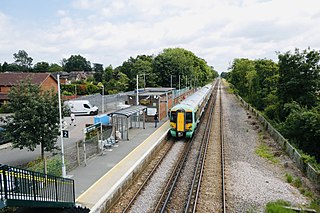British Railways (BR), which from 1965 traded as British Rail, was a state-owned company that operated most rail transport in Great Britain from 1948 to 1997. Originally a trading brand of the Railway Executive of the British Transport Commission, it became an independent statutory corporation in January 1963, when it was formally renamed the British Railways Board.

New Cross Gate is a railway station in New Cross, London, on the Brighton Main Line and the London Overground. It is 2 miles 70 chains down the line from London Bridge and is about 600 m (660 yd) west of New Cross station. It is in Travelcard Zone 2, and is operated by London Overground.

The London, Brighton and South Coast Railway was a railway company in the United Kingdom from 1846 to 1922. Its territory formed a rough triangle, with London at its apex, practically the whole coastline of Sussex as its base, covering a large part of Surrey. It was bounded on its western side by the London and South Western Railway (L&SWR), which provided an alternative route to Portsmouth. On its eastern side the LB&SCR was bounded by the South Eastern Railway (SER)—later one component of the South Eastern and Chatham Railway (SE&CR)—which provided an alternative route to Bexhill, St Leonards-on-Sea, and Hastings. The LB&SCR had the most direct routes from London to the south coast seaside resorts of Brighton, Eastbourne, Worthing, Littlehampton and Bognor Regis, and to the ports of Newhaven and Shoreham-by-Sea. It served the inland towns and cities of Chichester, Horsham, East Grinstead and Lewes, and jointly served Croydon, Tunbridge Wells, Dorking and Guildford. At the London end was a complicated suburban and outer-suburban network of lines emanating from London Bridge and Victoria, and shared interests in two cross-London lines.

Freightliner Group is a rail freight and logistics company headquartered in the United Kingdom. It is a subsidiary of Genesee & Wyoming.
The privatisation of British Rail was the process by which ownership and operation of the railways of Great Britain passed from government control into private hands. Begun in 1994, the process was largely completed by 1997. The deregulation of the industry was in part motivated by the enactment of EU Directive 91/440 in 1991, which aimed to create a more efficient railway network by creating greater competition.
In the railway system of Great Britain, a train operating company (TOC) is a railway undertaking operating passenger trains under the collective National Rail brand. TOCs have existed since the privatisation of the network under the Railways Act 1993.
The London and Croydon Railway (L&CR) was an early railway in England. It opened in 1839 and in February 1846 merged with other railways to form the London, Brighton and South Coast Railway (LB&SCR).

The Oxted line is a railway line in southern England. It runs from the Brighton Main Line at South Croydon in Greater London to Hurst Green Junction in Surrey, where its two branches diverge. The western branch continues via Lingfield to East Grinstead in West Sussex, whereas the eastern branch runs via Edenbridge in Kent and Crowborough in East Sussex to Uckfield. The line is named after the town of Oxted in Surrey and also serves parts of the London Borough of Croydon. The 18-mile-26-chain (29.5 km) South Croydon–East Grinstead section is electrified using the 750 V DC third-rail system and is double track throughout. The unelectrified Hurst Green Junction–Uckfield section is 24 mi 53 ch (39.7 km) in length and, south of Hever, is mostly single track.

The Brighton Main Line is a railway line in southern England linking London to Brighton. It starts at two termini in the capital, London Victoria and London Bridge, and the branches from each meet at East Croydon, from where the route continues southwards via Gatwick Airport to the coast. The line serves the suburbs of South London, as well as the towns of Redhill, Horley, Crawley, Haywards Heath and Burgess Hill.

Norwood Junction railway station is a National Rail station in South Norwood in the London Borough of Croydon, south London, and is in Travelcard Zone 4. It is 8 miles 55 chains down the line from London Bridge.

Carlisle railway station, or Carlisle Citadel, is a Grade II* listed railway station serving the cathedral city of Carlisle, Cumbria, England. It is on the West Coast Main Line, 102 miles (164 km) south-east of Glasgow Central and 299 miles (481 km) north north-west of London Euston. It is the northern terminus of the Settle and Carlisle Line, a continuation of the Midland Main Line from Leeds, Sheffield and London St Pancras. It was formerly the southern terminus of the partially-closed Waverley Route from Edinburgh. It is so named because it is adjacent to Carlisle Citadel, a former medieval fortress. The station is owned by Network Rail.

The Ely–Peterborough line is a railway line in England, linking East Anglia to the Midlands. It is a part of the Network Rail Strategic Route 5, SRS 05.07 and is classified as a secondary line. It is used by a variety of inter-regional and local passenger services from East Anglia to the West Midlands and North West, as well as freight and infrastructure traffic; it also links with the busy East Coast Main Line at its western end. Fenland District council put forward their Rail Development Strategy for the route in 2012, which includes infrastructure upgrades for the intermediate stations, improved frequencies for the services using it and establishing a Community Rail Partnership for the line in 2013–14.

The Electro-Motive Diesel (EMD) Class 66 are Co-Co diesel locomotives built by EMD for the European heavy freight market. Designed for use in Great Britain as the British Rail Class 66, a development of the Class 59, they have been adapted and certified for use in other European countries. Outside Europe, 40 locomotives have been sold to Egyptian Railways for passenger operation.

Reddish South railway station is a stop on the Stockport–Stalybridge line in Reddish, Stockport, England. The station, used by only 26 passengers in 2013/14, is one of the quietest on the UK rail network. From May 1992 until May 2018, it was served by parliamentary services in order to avoid a formal proceeding to close the line. Despite the low passenger numbers, the line itself is used regularly for freight traffic and empty stock transfers.

The Sheffield District Railway was a 3+1⁄2-mile (6 km) railway line in South Yorkshire, England. It was built to give the Lancashire, Derbyshire and East Coast Railway access to Sheffield, primarily for goods traffic, for which a large goods depot at Attercliffe, in Sheffield, was built. The construction was sponsored by the LD&ECR and the Great Eastern Railway together, with the support of the Midland Railway, which agreed running powers over sections of its own lines. The Sheffield District Railway opened in 1900. The LD&ECR operated the passenger service, although the Midland Railway later ran passenger trains too. The SDR did not have rolling stock and did not operate trains itself. The LD&ECR was absorbed by the Great Central Railway in 1907, and the GCR inherited the LD&ECR running powers.

The Redhill–Tonbridge line is a 19-mile-56-chain (31.70 km) railway line in South East England. It runs from the Brighton Main Line at Redhill in Surrey to the South Eastern Main Line at Tonbridge in Kent. There are five intermediate stations: Nutfield, Godstone, Edenbridge, Penshurst and Leigh. All passenger services run as all-stations shuttles between Redhill and Tonbridge, and are operated by Southern using Class 377 electric multiple units.

DB Cargo France is a French rail freight operator. It is presently a subsidiary of the German state-owned logistics company DB Cargo.

A train station, railroad station, or railroad depot and railway station is a railway facility where trains stop to load or unload passengers, freight, or both. It generally consists of at least one platform, one track, and a station building providing such ancillary services as ticket sales, waiting rooms, and baggage/freight service. Stations on a single-track line often have a passing loop to accommodate trains travelling in the opposite direction.
Pyewipe Junction engine shed was a motive power depot operated by the Great Eastern Railway (GER) located in Lincolnshire, England.

Dukeries Junction, originally Tuxford Exchange, was a railway station near Tuxford, Nottinghamshire, England. The station opened in 1897 and closed in 1950. It was located at the bridge where the Lancashire, Derbyshire and East Coast Railway crossed over the East Coast Main Line (ECML), with sets of platforms on both lines. The high-level location is now part of the High Marnham Test Track.














